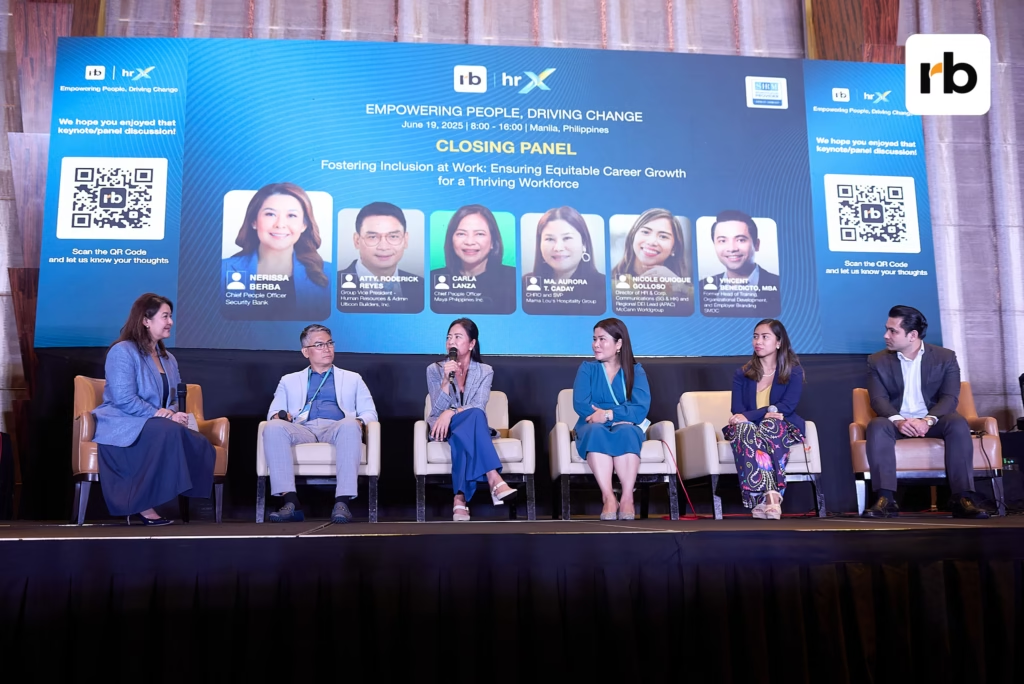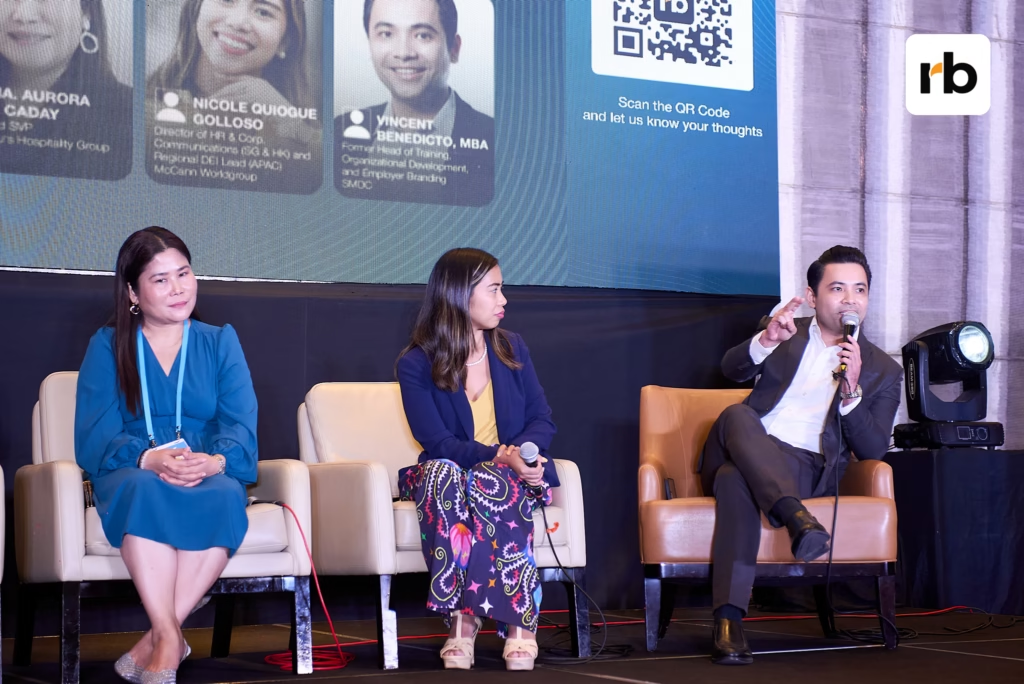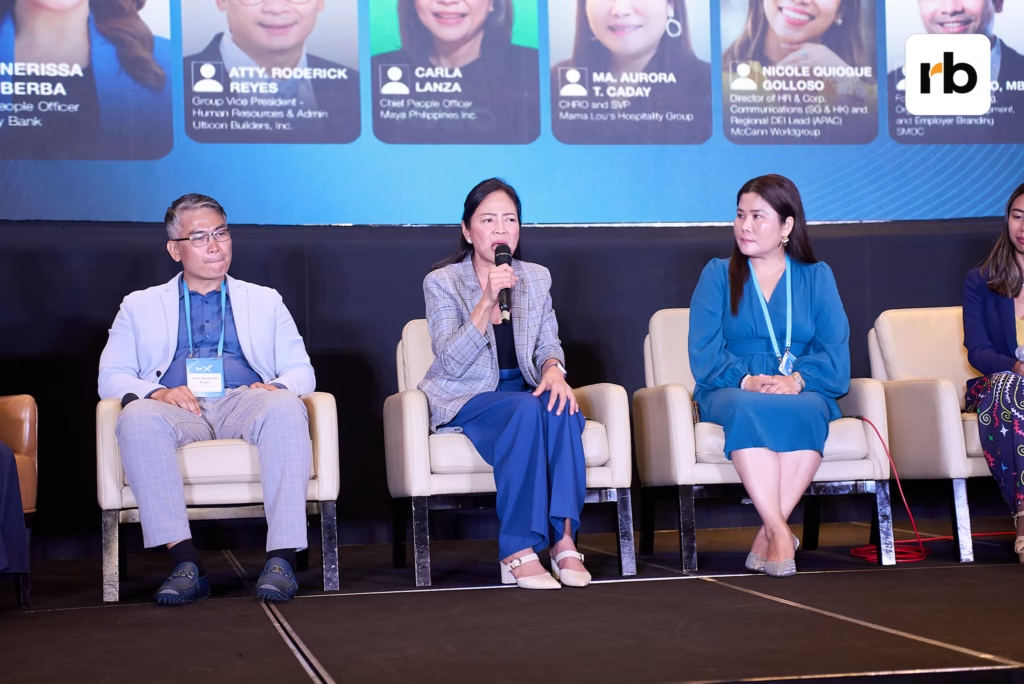At the hrX Philippines 2025 closing panel, something powerful happened—not because it was planned, but because it was real.
Six voices took the stage not to preach from a distance, but to get into the heart of what it really means to lead people today. And for once, it didn’t sound like corporate jargon. It sounded like the truth.
Moderated by Nerissa Berba, Chief People Officer of Security Bank, the panel assembled a rare mix of visionaries and practitioners:
- Ma. Aurora T. Caday, Chief Human Resource Officer, Tim Hortons Philippines
- Vincent Benedicto, MBA, Former Head of Training and Organizational Development, SMDC
- Atty. Roderick Reyes, Ulticon Builders
- Nicole Quiogue Golloso, McCann Worldgroup
- Carla Lanza, Maya Philippines
The panel was titled, “Fostering Inclusion at Work: Ensuring Equitable Career Growth for a Thriving Workforce,” but what followed was far more than a decision, it was a dismantling of comfort zones, an honest reckoning and a practical guide to building cultures that see people.
Reimagining Representation: Inclusion Starts Where Decisions Are Made
“Culture is tricky. It’s something you don’t just roll out. People have to feel it.” – Vincent Benedicto
Vincent Benedicto opened a discussion with something rare in DEI conversations: a step-by-step approach that didn’t rely on ideals, but on execution.
In his words, inclusion isn’t just representation on paper—itt’s who gets to sit at the table when decisions are made.
He laid out five building blocks: starting with representation, where cascading structure ensures diversity isn’t confined to entry-level roles. Then comes data analytics, the lens through which age, tenure and talent patterns are made visible.
“You need to generate insights that allow AI to supplement—not replace—your people’s decisions,” he said.
When it comes to identifying high-potential employees, Vincent reframed the usual KPIs:
“High potential is not just someone who performs. It’s someone who contributes to culture and drives innovation.”
From equitable programs to reward systems to accountability, Vincent’s point was clear: if the structure isn’t designed to be fair, inclusion won’t follow.
Turning Numbers Into Narratives: The Power of Data in People Strategy
Vincent pushed further on a truth often avoided in HR: we romanticized intuition, but undervalue evidence.
With a calm but firm tone, he explained how organizations must personalize programs to the real composition of their teams. “Monetary rewards are good, but public recognition is powerful,” he said, nodding to the silent impact of being seen.
He ended with a sharp reminder: “He must be accountable—but so should every employee. We all share
Walk the Talk: How Leaders Can Make Inclusion Tangible
When Aurora Caday took the mic, the room quieted. There was clarity in how she spoke—practical, unafraid and deeply people-first.
“Even well-intentioned actions like forming support groups can backfire if they’re not thought through,” she said. “Bias doesn’t always wear a name tag.”
Aurora offered three grounded strategies. First: listen deeply. Leaders need to hear not just what’s said, but what’s often withheld. “Transparency prevents misunderstanding,” she said. Second: model inclusiveness. You can’t champion equity from behind a desk. “Walk the talk,” she said, without hesitation. And third: build accountability into DEI systems so they can’t be skipped or sidelined.
“We also have to address generational gaps—not to fix them, but to learn from them,” she added.
“Each generation brings something the others don’t.”
Beyond Comfort Zones: Building Systems That Check Bias Before It Start
Nicole Golloso, with her calm command, delivered some of the most necessary discomforts of the afternoon.
“You need to be comfortable with the uncomfortable,” she said. “We don’t grow by saying yes to everything.”
Nicole pulled back the curtain on how McCann Worldgroup doesn’t just talk about fairness—it audits it. From biennial salary reviews to “transparency talks,” Nicole explained how they build calibrated decision-making into daily practice.
“Feedback should not be a guessing game. We use talent trackers not to monitor people—but to ensure that what’s said matches what’s real.”
She added that in 2023, they launched transparency talks to explain how promotions happen, how salary is distributed and how visibility is built into their system—not earned through office politics.
Embedding DEI in the Mission: Inclusion That Lives Beyond Paper
“If DEI is not in your mission statement, then it’s only performative.” – Atty. Roderick Reyes
Atty. Reyes brought grounding. Where the others spoke strategy, he spoke soul.
“In the mining company I worked for, our top three performers were cross-dressers,” he shared.
“They were fun, meticulous and deeply committed. If we had judged them by appearance, we’d have missed out on excellence.”
He compared organizations to anatomy. “We are one body. Different parts, different functions—but each one essential.”
He called for DEI to be embedded not in reports but in the vision, values and voice of the company.
“Start at the top. Make your leaders your role models. That’s how culture changes.”
Growth Without Guesswork: Structuring Careers to Retain and Empower
Carla Lanza brought the conversation home. “Fair growth isn’t a philosophy—it’s structure,” she said.
She explained how mapping career paths, not just vertically but laterally, dismantles invisible gatekeeping.
“When people can see how to grow, they stop guessing. They stay.”
Carla shared a moment that stayed with many in the audience:
“One of my people said to me, ‘I don’t need to leave to be seen.’ And that’s when I knew, visibility is retention.”
Ownership Through Dialogue: Why Listening Is the First Step to Change
The audience, made up of HR leaders from across the Philippines, raised a pressing concern: What happens when companies say they use AI and DEI tools—but don’t?
The panel didn’t sidestep the question.
Atty. Reyes urged companies to use climate surveys and exit interviews as a mirror. “Use them to escalate issues backed by data, not emotion,” he said. “Then report upward—with moral confidence.”
Nicole followed: “If your managers aren’t having these conversations, maybe no one told them they should. But you need to start.”
She described a company-wide exercise that started with one question: “What does inclusion look like from where you stand?” They shut down operations for a day and co-created solutions—without senior leaders in the room. “Because inclusion isn’t a top-down policy. It’s a bottom-up necessity.”
Vincent closed the loop with a reminder: “Your DEI programs must be tied to KPIs—financial, customer and operational. That’s how it becomes sustainable.”
Carla reinforced that data is your story. “If you can’t explain what your DEI program is for—don’t expect your people to believe in it.”
Inclusion Is Not a Department. It’s a Decision—Made Every Day.
As the discussion drew to a close, Nerissa Berba offered a reflection that felt more like a challenge than a conclusion.
“It’s not HR’s job to promote you,” she said. “That’s your manager’s role. But HR should make sure your work is visible, your value is understood and your growth isn’t left to chance.”
Her words echoed long after the panel ended. Because in the end, inclusion isn’t just about policy or optics or hiring statistics. It’s about removing the guesswork from growth. It’s about making feedback real. It’s about deciding, every day, to choose fairness—not just when it’s convenient, but especially when it’s not.
The truth is, people don’t leave because they’re not appreciated.
They leave because they’re left wondering.
And the most human thing a workplace can do—
Is to make sure no one ever has to.
#HRX2025 #DEI #LeadershipInclusion #CareerGrowth #HumanResources #EmployeeExperience #WorkplaceEquity #HRTransformation #FutureOfWork #PeopleFirst #InclusionMatters #rockbirdmedia #GrowBeyond


















